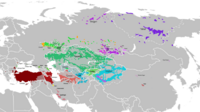Tuoba language
| Tuoba | |
|---|---|
| T'opa | |
| Tabγač, Taγbač | |
| Native to | Tuoba |
| Region | Northern China and Mongolia |
| Ethnicity | Tuoba |
| Era | 5th century |
| Serbi script[1] | |
| Language codes | |
| ISO 639-3 | None (mis) |
| Glottolog | None |
Tuoba (Tabγač or Tabghach; also Taγbač or Taghbach; Chinese: 拓跋) is an extinct language spoken by the Tuoba people in northern China around the 5th century AD during the Northern Wei dynasty. It has variously been considered to be of Turkic or (Para-)Mongolic affiliation.[2][3][4]
Classification
[edit]Alexander Vovin (2007) identifies the Tuoba language as a Mongolic language.[2]
On the other hand, Juha Janhunen proposed that the Tuoba might have spoken an Oghur Turkic language.[3] According to Peter Boodberg, the Tuoba language was essentially Turkic with Mongolic admixture.[4] Chen Sanping noted that the Tuoba language "had both" Turkic and Mongolic elements.[5][6]
Liu Xueyao stated that Tuoba may have had their own language, which should not be assumed to be identical with any other known languages.[7]
Andrew Shimunek (2017) classifies Tuoba (Taghbach) as a "Serbi" (i.e., para-Mongolic) language. Shimunek's Serbi branch also consists of the Tuyuhun and Khitan languages.[1]
Morphology
[edit]Some functional suffixes are:[1]
- *-A(y) ~ *ʁa(y) ‘verbal noun suffix’
- *-Al ~ *-l ‘deverbal noun suffix’
- **čɪ ~ **či ‘suffix denoting occupations’ <cognates with Turkic suffix "-či"
- **-mɔr/-mʊr (萬) ‘deverbal noun suffix’ <cognates with Turkic suffix "-mur"[8]
- **-n ‘plural suffix’
Lexicon
[edit]Selected basic Taghbach words from Shimunek (2017) are listed below. Forms reconstructed using the comparative method are marked with one asterisk (*), while forms reconstructed according to the Chinese fanqie spellings and/or rhymes of the traditional Chinese philological tradition are marked with two asterisks (**) (originally marked as ✩ by Shimunek 2017).[1]
| Taghbach (reconstructed form) | Taghbach (original Chinese transcription) | English meaning | Original Chinese gloss |
|---|---|---|---|
| *agyɪl ~ *agɪl | 屋引 | house | 房 |
| *čʰɪrnɔ | 叱奴 | wolf | 狼 |
| **dɪʁa | 地何 | writing, book, document | 書 |
| **ɦatśir̃ | 阿真 | food | 飲食 |
| *ɦorbǝl | 嗢盆 | warmth | 溫 |
| *ɪrgɪn | 俟懃 | above, superior | 尚 |
| **kʰɪl- | 乞 | to speak | - |
| **kʰɪr- | 契 | to kill someone | 殺人 |
| **kʰɪrʁayčɪn | 契害真 | assassins | 殺人者 |
| *ñaqañ | 若干 | dog | 狗 |
| *pary-al | 拔列 | bridge | 梁 |
| **pʰatala | 破多羅 | rice water | 潘 |
| *qɔw/*qəw | 侯 | pig, boar | 亥 |
| **tʰaʁ | 托 | dirt, soil, earth | 土 |
| *tʰʊʁnar | 土難 | mountain | 山 |
| **tʰʊʁay | 吐奚 | ancient | 古 |
| *uwl/*ʊwl | 宥連 | cloud | 雲 |
| *yirtʊqañ/*yirtʊqan | 壹斗眷 | bright | 明 |
| *žirpəŋ | 是賁 | raised earth, embankment | 封 |
| **žiʁlʊ | 是樓 | high, tall | 高 |
References
[edit]Citations
[edit]- ^ a b c d Shimunek, Andrew (2017). Languages of Ancient Southern Mongolia and North China: a Historical-Comparative Study of the Serbi or Xianbei Branch of the Serbi-Mongolic Language Family, with an Analysis of Northeastern Frontier Chinese and Old Tibetan Phonology. Wiesbaden: Harrassowitz Verlag. ISBN 978-3-447-10855-3. OCLC 993110372.
- ^ a b Vovin, Alexander. "Once Again on the Tabghach Language". Mongolian Studues XXIX (2007).
- ^ a b Juha Janhunen, (1996), Manchuria: An Ethnic History, p. 190
- ^ a b Holcombe, Charles (2001). The Genesis of East Asia: 221 B.C. - A.D. 907. p. 132.
- ^ Chen, Sanping (2005). "Turkic or Proto-Mongolian? A Note on the Tuoba Language". Central Asiatic Journal. 49 (2): 161–174. ISSN 0008-9192. JSTOR 41928391.
- ^ Holcombe 2001, p. 248
- ^ Liu Xueyao p. 83-86
- ^ "mUr". Nişanyan Sözlük.
Bibliography
[edit]- Liu, Xueyao (2005). 歷代胡族王朝之民族政策. 知書房出版集團. ISBN 9789867151018.
- Liu, Xueyao (2012). 鮮卑列國:大興安嶺傳奇. 三聯書店(香港)有限公司. ISBN 9789628904327.

